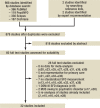Somatoform disorders and medically unexplained symptoms in primary care
- PMID: 25939319
- PMCID: PMC4442550
- DOI: 10.3238/arztebl.2015.0279
Somatoform disorders and medically unexplained symptoms in primary care
Abstract
Background: The literature contains variable figures on the prevalence of somatoform disorders and medically unexplained symptoms in primary care.
Methods: The pertinent literature up to July 2014 was retrieved by a systematic search in the PubMed/MEDLINE, PsychInfo, Scopus, and Cochrane databases. The methodological quality and heterogeneity (I2) of the retrieved trials were analyzed. The prevalence rates of medically unexplained symptoms, somatoform disorders, and their subcategories were estimated, along with corresponding 95% confidence intervals (CI), with the aid of random-effects modeling.
Results: From a total of 992 identified publications, 32 studies from 24 countries involving a total of 70 085 patients (age range, 15-95 years) were selected for further analysis. All had been carried out between 1990 and 2012. The primary studies were more heterogeneous overall; point prevalences for the strict diagnosis of a somatization disorder ranged from 0.8% (95% CI 0.3-1.4%, I2 = 86%) to 5.9% (95% CI 2.4-9.4%, I2 = 96%), with higher estimated prevalences in studies that applied less restrictive diagnostic criteria. At least one type of somatoform disorder was diagnosable by DSM-IV and/or ICD-10 criteria in a fraction of primary-care patients that ranged from 26.2% (95% CI 19.1-33.3%, I2 = 98%) to 34.8% (95% CI 26.6-44.6%; I2 = 92%). The percentage of patients complaining of at least one medically unexplained symptom ranged from 40.2% (95% CI 0.9-79.4%; I2 = 98%) to 49% (95% CI 18-79.8%, I2 = 98%). The quality of the studies, in general, was only moderate. No relationship was found between study quality and prevalence estimates.
Conclusion: The statistical heterogeneity of the included studies is very high. Somatoform disorders and medically unexplained symptoms are more common than generally assumed. The found prevalences highlight the importance of these conditions in primary care.
Figures


References
-
- Escobar JI, Waitzkin H, Silver RC, Gara M, Holman A. Abridged somatization: a study in primary care. Psychosom Med. 1998;60:466–472. - PubMed
-
- Kroenke K, Spitzer RL, DeGruy III FV, et al. Multisomatoform disorder: an alternative to undifferentiated somatoform disorder for the somatizing patient in primary care. Arch Gen Psychiatry. 1997;54:352–358. - PubMed
-
- Barsky AJ, Orav EJ, Bates DW. Somatization increases medical utilization and costs independent of psychiatric and medical comorbidity. Arch Gen Psychiatry. 2005;62:903–910. - PubMed
Publication types
MeSH terms
LinkOut - more resources
Full Text Sources
Other Literature Sources
Medical

